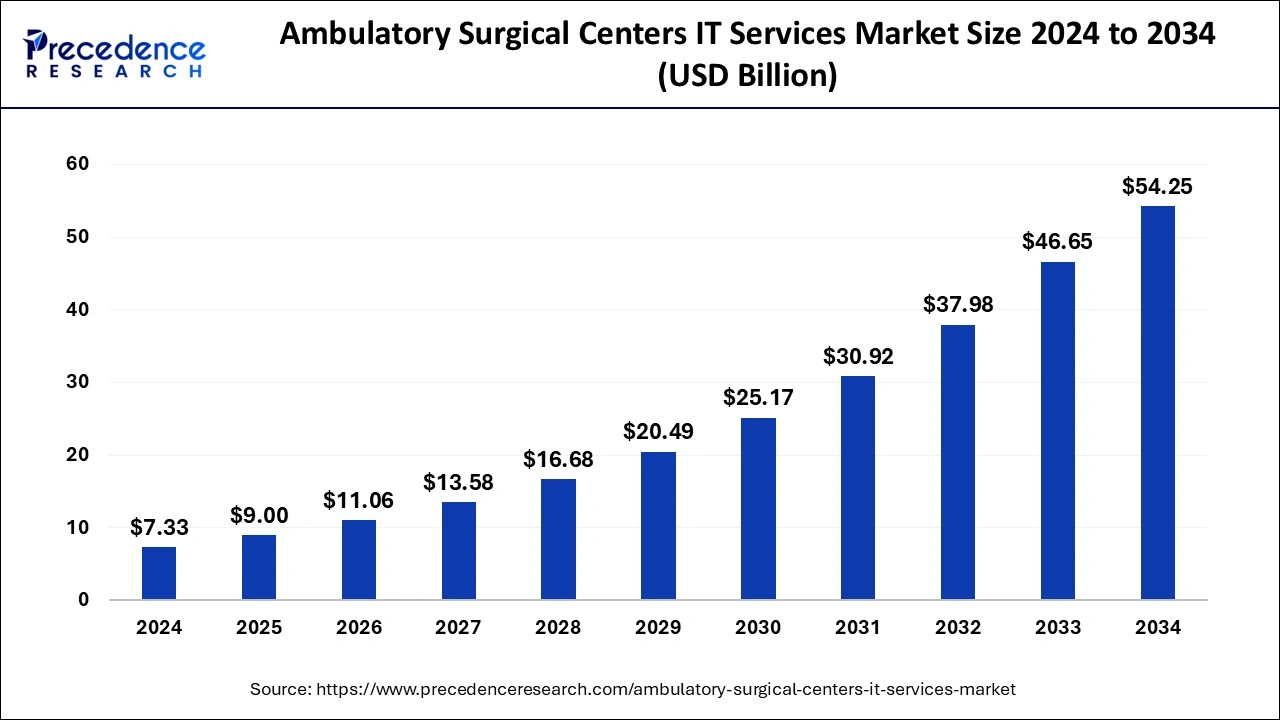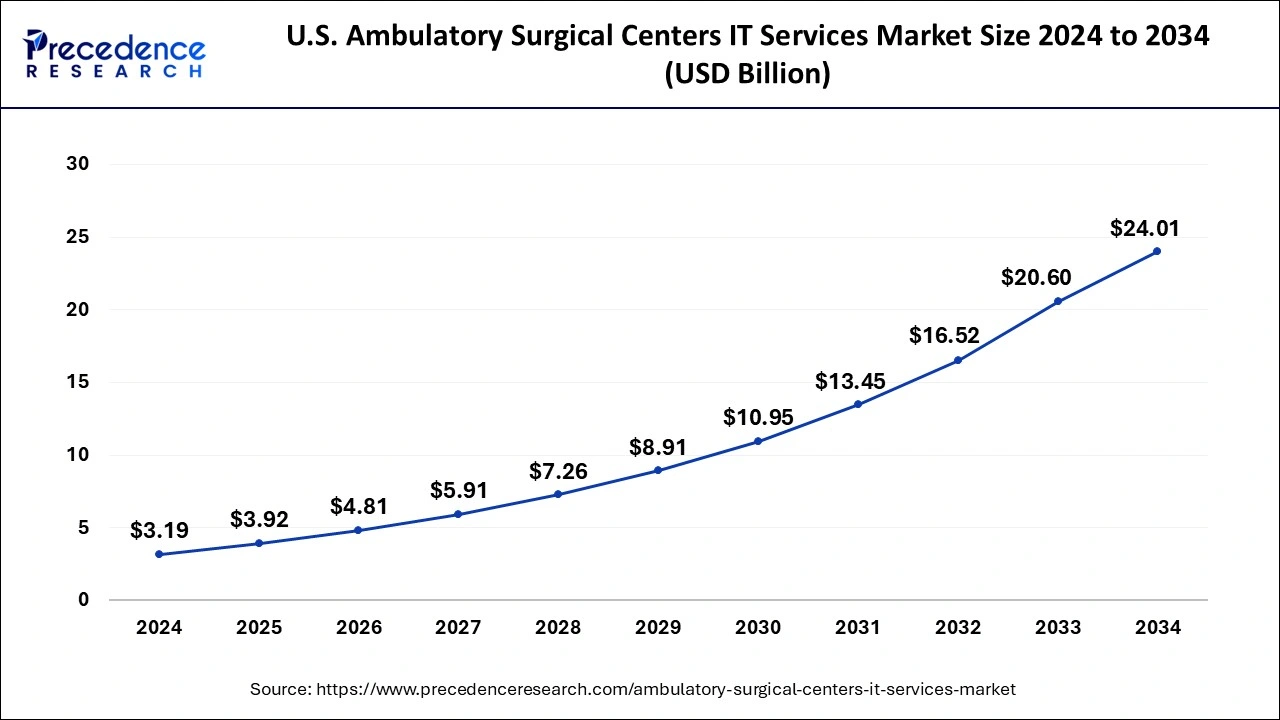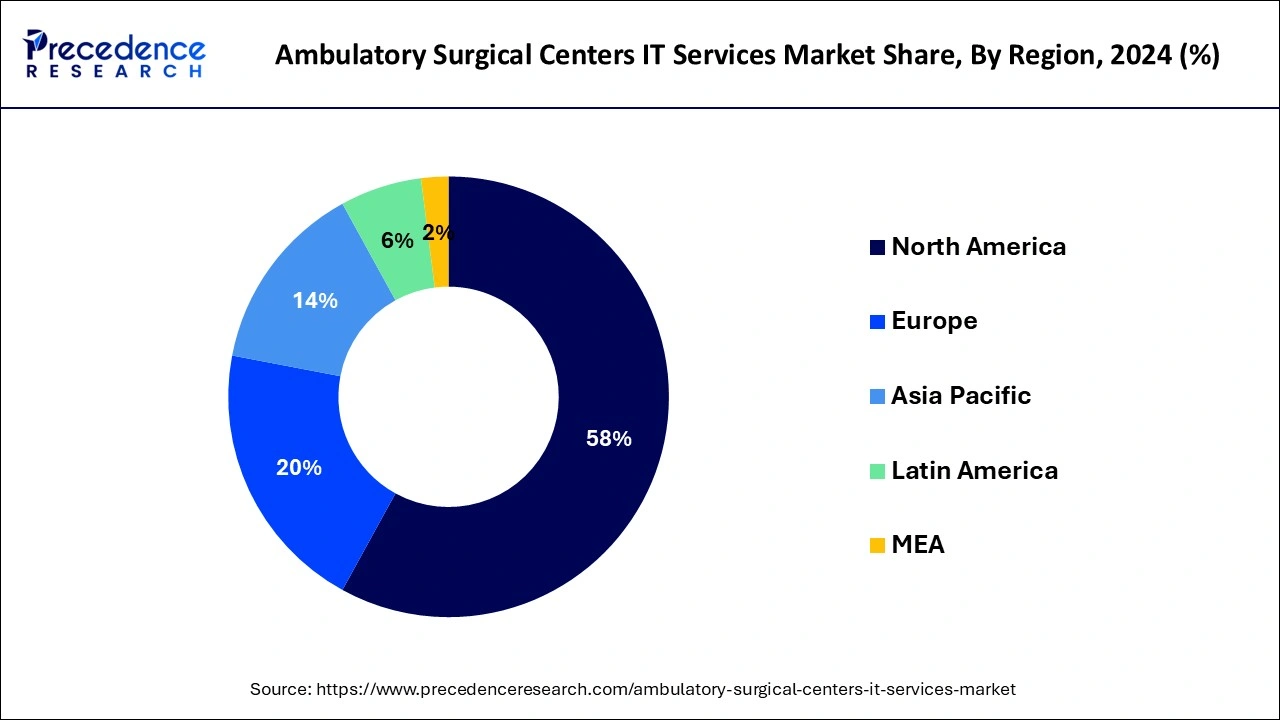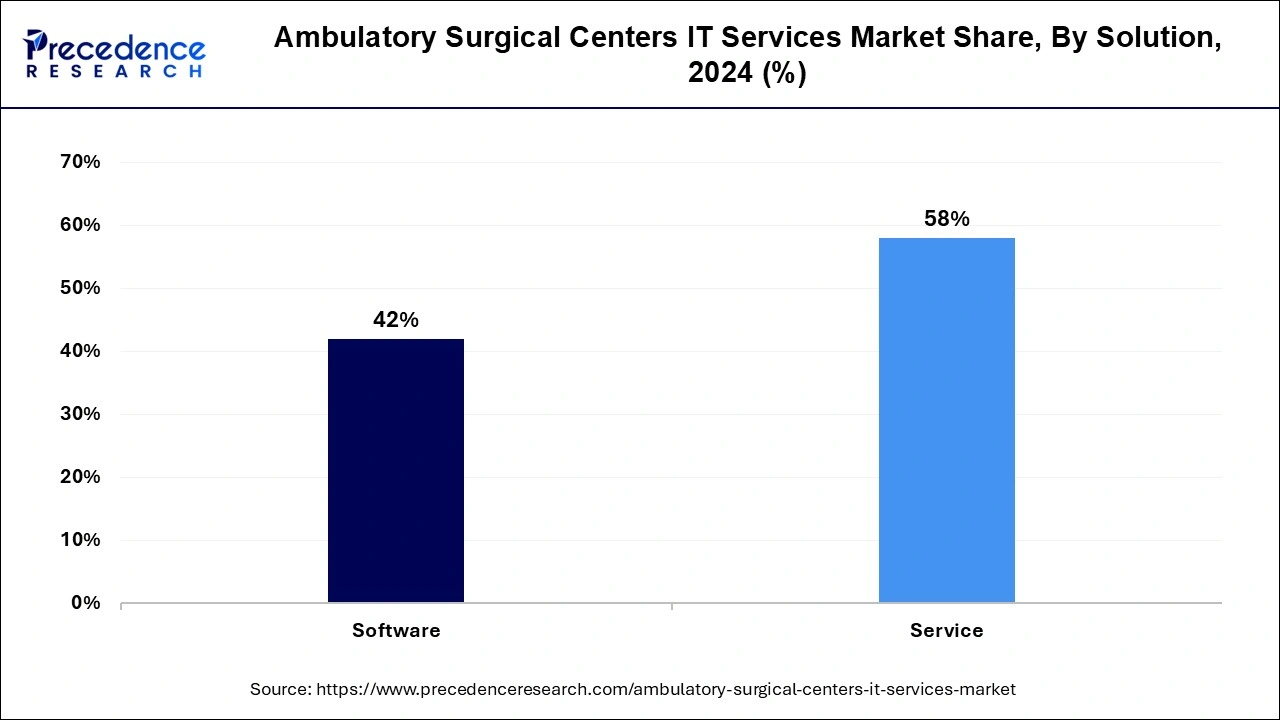List of Contents
Ambulatory Surgical Centers IT Services Market Size and Growth 2025 to 2034
The global ambulatory surgical centers IT services market size was estimated at USD 7.33 billion in 2024 and is predicted to increase from USD 9 billion in 2025 to approximately USD 54.25 billion by 2034, expanding at a CAGR of 22.16% from 2025 to 2034. IT services reduce human errors and increase overall operational efficiency by streamlining administrative activities, patient data management, scheduling, billing, and inventory management.

Ambulatory Surgical Centers IT Services Market Key Takeaways
- In terms of revenue, the global ambulatory surgical centers IT services market was valued at USD 7.33 billion in 2024.
- It is projected to reach USD 54.25 billion by 2034.
- The market is expected to grow at a CAGR of 22.16% from 2025 to 2034.
- North America has held the largest revenue share of 58% in 2024.
- Asia Pacific is expected to grow at a significant rate in the global market.
- By service type, the electronic health record segment has contributed more than 33%of revenue share in 2024.
- By service type, the clinical documentation segment is expected to grow the fastest in the market.
- By solution, the service segment has held the biggest revenue share of 58% in 2024.
- By solution, the software segment is expected to show the fastest growth in the market over the forecast period.
- By deployment mode, the cloud-based segment dominated the market with the highest revenue share of 86% in 2024.
- By deployment mode, the on-premise is expected to grow rapidly in the market in the upcoming years.
U.S.Ambulatory Surgical Centers IT Services Market Size and Growth 2025 to 2034
The U.S. ambulatory surgical centers IT services market size was estimated at USD 3.19 billion in 2024 and is predicted to be worth around USD 24.01 billion by 2034 at a CAGR of 22.37% from 2025 to 2034.

North America dominated the global ambulatory surgical centers IT services market in 2024. The necessity for effective patient data management and healthcare processes, as well as the growing demand for outpatient treatments, have all contributed to the expansion of the ambulatory surgery centers (ASCs) IT services market in North America. ASC IT services are a fiercely competitive business in North America, where a number of well-known companies provide a broad range of products and services that are specifically designed to meet the requirements of ambulatory surgery centers. In addition, a wave of creative entrepreneurs and digital companies have entered the market, offering specialized solutions to deal with new problems in the healthcare sector.

Asia Pacific is expected to grow at a significant rate in the global ambulatory surgical centers IT services market. The region's market is changing quickly as a result of a number of factors, including rising healthcare costs, advances in technology, and an increase in the demand for outpatient surgical operations. ASCs are growing in popularity because they are convenient, economical, and effective at providing surgical treatment. ASCs are spending money on practice management software to better manage administrative, billing, and scheduling duties. These software programs offer a smooth workflow by integrating with EHR systems. Healthcare IT must prioritize data security and adherence to laws like the Health Insurance Portability and Accountability Act. To protect patient data and make sure that regulations are followed, ASCs are investing in compliance and cybersecurity solutions.
Market Overview
IT services are being used by ASCs more frequently in order to improve patient care, streamline operations, and adhere to legal regulations. This trend is being driven by technological advancements like telemedicine, cloud computing, electronic health records (EHR), and mobile health applications. ASCs can enhance staff communication, automate administrative duties, and allocate resources optimally with the use of IT services. Because ASCs are able to function more efficiently with fewer resources, this ultimately results in enhanced efficiency and cost savings. The telehealth services industry, especially ASCs, has benefited from the COVID-19 epidemic by growing in popularity. ASCs can provide patients with remote consultations, pre-operative evaluations, and post-operative care thanks to IT technologies that make it easier to integrate telehealth systems.
The ambulatory surgical centers IT services market is getting more and more competitive as more vendors provide customized products made to meet the particular requirements of ASCs. Larger healthcare IT companies are acquiring smaller businesses to increase their services and market share, which is another factor contributing to market consolidation. There is an increasing tendency toward outpatient operations, which are usually less expensive than those carried out in traditional hospital settings, as healthcare prices continue to climb. This rise is largely driven by ASCs, and IT services are critical to handling the rising number of patients and procedures. ASCs must adhere to a number of regulations, such as Meaningful Use standards and HIPAA (Health Insurance Portability and Accountability Act).
Ambulatory Surgical Centers IT Services Market Growth Factors
- The ambulatory surgical centers IT services market is becoming more and more common as healthcare systems throughout the world move toward outpatient services in an effort to cut costs and boost efficiency. The demand for effective IT systems to handle patient records, scheduling, billing, and compliance is being driven by the increase in outpatient treatment.
- The ambulatory surgical centers IT services market is required to comply with multiple standards, including Meaningful Use and HIPAA (Health Insurance Portability and Accountability Act), which require the use of electronic health records (EHR) and other IT solutions. The need for IT services that guarantee data security, privacy, and interoperability is driven by compliance.
- The ambulatory surgical centers IT services market strives to keep patients happy and safe while streamlining processes and cutting expenses. IT services provide ways to save costs and increase operational efficiency by automating administrative chores, maximizing resource use, and enhancing staff communication.
- The move towards patient-centric care emphasizes improving patient outcomes and experiences. The ambulatory surgical centers IT services market can provide better patient satisfaction and engagement when they use IT services that facilitate personalized care through patient portals, remote monitoring tools, and telehealth services.
- Patients want easy access to treatments, clear pricing, and easy communication with healthcare professionals as they become more involved in managing their own healthcare. IT services are essential in fulfilling these demands by providing digital communication channels, smartphone health apps, and online appointment booking.
- To increase their reach and service offerings, the ambulatory surgical centers IT services market is increasingly partnering with physician groups, healthcare systems, and other stakeholders. IT services that enable collaboration, interoperability, and data sharing amongst vario healthcare companies become crucial for successful alliances and attempts at industry consolidation.
Ambulatory Surgical Centers IT Services Market Scope
| Report Coverage | Details |
| Growth Rate from 2025 to 2034 | CAGR of 22.16% |
| Market Size in 2025 | USD 9 Billion |
| Market Size by 2034 | USD 54.25 Billion |
| Largest Market | North America |
| Base Year | 2024 |
| Forecast Period | 2025 to 2034 |
| Segments Covered | By Service, By Solution, and By Deployment Mode |
| Regions Covered | North America, Europe, Asia-Pacific, Latin America, and Middle East & Africa |
Market Dynamics
Driver
Remote monitoring and telehealth
Sophisticated remote monitoring and telehealth solutions have been made possible by technological advancements, especially in the areas of data analytics, wearables, and telephony. Because they are more affordable, more convenient, and offer specialized care, ambulatory surgical centers are fast becoming the go-to option for numerous surgical procedures. Through the remote monitoring of patient's vital signs, medication compliance, and post-operative recovery status, these services assist healthcare providers in the early detection of potential issues, minimize needless hospital readmissions, and maximize resource efficiency. However, legal obstacles, including licensing requirements, payment guidelines, and privacy issues with data, still affect how widely these services are used in ambulatory surgery facilities.
Restraint
Interoperability issues
The ambulatory surgical centers IT services market can face substantial challenges in terms of interoperability due to the complex nature of healthcare systems and the wide variety of technology employed by various providers. The various IT systems utilized in ASCs don't have standardized data formats, protocols, or interfaces. It is challenging for systems to interchange information without interruption due to this lack of consistency. ASCs frequently use a variety of software programs for a range of functions, including practice administration, electronic health records (EHR), scheduling, billing, and billing. Ineffective communication between these systems might result in data silos and inefficiencies.
Opportunity
Data analytics and business intelligence
ASCs can examine their operational data, including patient flow, resource usage, and inventory control, with the use of BI and data analytics technologies. ASCs can enhance patient throughput, cut expenses, and optimize their processes by identifying inefficiencies or bottlenecks. ASC revenue cycle management procedures can be streamlined with the use of data analytics. ASCs can detect coding problems, monitor reimbursement trends, and maximize revenue collection by examining billing and claims data. ASCs may guarantee that resources are allocated effectively to satisfy patient demands while eliminating waste by evaluating past data and projecting future demand. ASCs can monitor adherence to accreditation standards and regulatory obligations with the use of BI technologies. ASCs can find non-compliance issues and take corrective action to reduce risks by gathering and evaluating compliance data.
Service Type Insights
The electronic health record holds the largest share of the global ambulatory surgical centers IT services market as a result of a number of factors, including the desire for better patient care and operational efficiency, as well as regulatory mandates and technological improvements. EHR systems are essential for improving clinical workflows, expediting documentation procedures, and promoting provider communication in the ASC-serving IT services industry. Numerous clinical processes in ASCs, including patient registration, pre-operative evaluations, intraoperative recording, post-operative care, and billing, are automated and streamlined by EHR systems. EHR systems produce an abundance of data that can be used for quality improvement projects, performance monitoring, and clinical decision-making.
The clinical documentation segment is expected to grow the fastest in the ambulatory surgical centers IT services market. Effective clinical documentation is essential in ASCs to guarantee fast and accurate patient treatment, regulatory compliance, and good provider-to-provider communication. Electronic health record system implementation and customization to meet ASC needs. Typically, these systems have tools for recording treatment plans, demographics, medical histories, prescriptions, and progress notes for each patient. Created and modified templates and forms in EHR/EMR systems to record particular data items needed by ASCs, like anesthetic records, operating notes, postoperative instructions, and preoperative assessments.
Solution Insights
The service segment held the largest share of the ambulatory surgical centers IT services market in 2024 and is expected to grow further during the forecast period. In the market for IT services for ambulatory surgical centers (ASCs), the service sector usually consists of a variety of products and services designed to satisfy the unique technical requirements of ASCs. These services are intended to increase operational effectiveness, optimize workflows, guarantee regulatory compliance, and enhance patient care in the context of ambulatory surgery. Delivering thorough training courses to ASC employees to guarantee their competence in utilizing IT technologies. This could involve instructional materials, online classes, and on-site training. Continuous technical support services to handle concerns, solve issues, and guarantee the efficient operation of IT systems.

The software segment is expected to show the fastest growth in the ambulatory surgical centers IT services market over the forecast period. The software segment usually includes a range of software solutions that are customized to meet the unique requirements of ASCs. In ASCs, these software programs are essential for optimizing workflow, increasing productivity, guaranteeing legal compliance, and boosting patient care. Digital patient records, which include prescriptions, treatment plans, medical histories, and other pertinent data, are kept up to date with the aid of EHR systems made specifically for ASCs. Practice management software helps ASCs handle administrative duties like appointment scheduling, invoicing and billing, processing insurance claims, and inventory control. Specialized software programs called surgical management systems are made to make it easier for ASCs to plan, schedule, and coordinate surgical procedures.
Deployment Mode Insights
The cloud-based segment dominated the ambulatory surgical centers IT services market in 2024. In the ambulatory surgical centers IT services market, the term "cloud-based segment" designates a particular class of IT services and solutions that are accessible and provided through cloud computing infrastructure. Cloud-based IT services are advantageous in the context of ASCs, which are medical institutions that perform surgery on an outpatient basis. Staff members at ASC may access vital data and apps remotely thanks to cloud-based solutions, which are accessible from any location with an internet connection. Pay-per-use or subscription models are common for cloud-based systems, which do not require significant upfront infrastructure costs. This can be very helpful for ASCs, as they could have small IT budgets.
The on-premise is expected to grow rapidly in the ambulatory surgical centers IT services market in the upcoming years. The on-premise segment relates to the deployment approach in which the IT infrastructure and applications are set up and maintained locally on the ASC's property. According to this arrangement, the ASC normally buys or licenses the software, installs it on their own computers or servers, and oversees the whole IT infrastructure either internally or with the assistance of outside vendors. This section contrasts with Software as a Service (SaaS) or cloud-based products, where the software is hosted online and accessed via a web browser. Although on-premise solutions provide more flexibility and control, they frequently come with a higher initial cost for software licenses, hardware, and IT staff for upkeep and updates.
Ambulatory Surgical Centers IT Services Market Companies
- Cerner Corporation
- Allscripts Healthcare Solutions Inc
- McKesson Corporation
- Medical Information Technology Inc
- Advanced Data Systems Corporation
- Surgical Information Systems
- NextGen Healthcare
- Philips Healthcare
Recent Developments
- In January 2024, Leading international alternative asset management company TPG (NASDAQ: TPG) today announced a sizable strategic investment in Compass Surgical Partners ("Compass" or the "Company"), a stand-alone full-service ASC development and management partner. The investment is being funded by TPG Growth, the company's middle market and growth equity vehicle, in collaboration with current partner Health Velocity Capital.
- In January 2024, The Center for Spine Economics, Outcomes & Research was established by Commons Clinic, a premier value-based physician group that is redefining musculoskeletal (MSK) care. This initiative will hasten the adoption of cutting-edge care models for the diagnosis, treatment, and management of spine problems. The center has committed to investing $100 million over the next ten years to improve the delivery of ambulatory spinal care.
Segment Covered in the Market
By Service
- EHR
- Clinical Documentation
- Practice Management
- Revenue Cycle Management
- Supply Chain Management
- Patient Engagement
- Others
By Solution
- Software
- Service
By Deployment Mode
- On-premise
- Cloud-based
By Geography
- North America
- Asia Pacific
- Europe
- Latin America
- Middle East & Africa
For inquiries regarding discounts, bulk purchases, or customization requests, please contact us at sales@precedenceresearch.com
Frequently Asked Questions
Ask For Sample
No cookie-cutter, only authentic analysis – take the 1st step to become a Precedence Research client